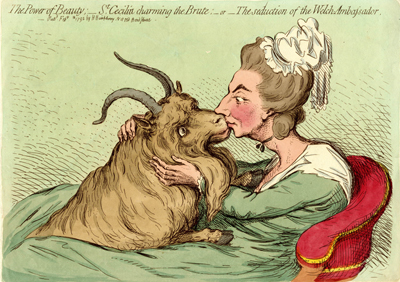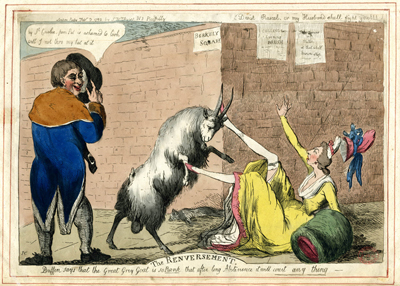The Power of Beauty. . .
The full title of this print (normalized) is The Power of Beauty: St Cecilia Charming the Brute, or the Seduction of the Welch Ambassador.. It shows Lady Cecilia Johnston seated in an armchair kissing a goat (a common symbol for a Welshman) which has assumed a discrete but clearly sexual position between her legs. Lady Cecilia had been a reliable target of Gillray's satire since 1780 when her distinctive profile lent itself to one of Gillray's earliest portrait caricatures. Two years later, her pretentions as an amateur musician made her an easy target for Gillray's St. Cecilia which caricatured her in a parody of the famous patron saint of music. And in 1787, she was one of the high society women in La Belle Assemblée, satirized for their devotion to the arts of love long after it was (to Gillray's mind at least) appropriate.

© Trustees of the British Museum
In The Power of Beauty, the sheer incongruity of the image continues the general satire of inappropriate, indeed in this case obscene, sexual desire. But unlike the satire in La Belle Assemblée, this print seems to refer to a specific incident with a specific person. So who is the "Welch Ambassador"? And what was the circumstance that gave rise to this print? Gillray is untypically reticent in this case, providing no more clues beyond the complete title, as if his audience would surely know without further eleboration.
Usually helpful in cases like this one, Thomas Wright and R.H. Evans provide only a tentative identification of the mysterious goat: "Sir W.W. Wynne(?)" and a less than illuminating explanation of the source—"Some forgotten anecdote of the scandal of the day." Dorothy George also mentions Sir Watkin Williams-Wynn, but adds that the identification is improbable, owing to the fact that the young baronet would have been just 19 at the time of the print. But she does refer the reader to "The Renversement," a print by Gillray's competitor, Isaac Cruikshank, also published in February 1792, which clearly refers to the same incident.

© Trustees of the British Museum
In The Renversement, we once again have Lady Cecilia confronted by a goat. But the sexual nature of the encounter is much more explicit. Lady Cecilia has fallen back with her legs spread open while the goat with large, prominent testicles stands aggressively erect, gazing at her private parts and seemingly moving forward. Those private parts are crudely alluded to in the vagina-like muff by her side and the playbill above her outstretched hand mentioning "Collings Evening Brush." The setting is Berkeley Square, an aristocratic haven, home to Lady Cecilia's good friend Horace Walpole among others, which suggests that the encounter is situated in high society.
But The Renversement includes another figure, an Irishman, not part of Gillray's print, who witnesses the event but looks away. Dorothy George identifies him as a "passing Irish chairman," but if so, why would HE feel "ashamed"? And why would he suggest that any interference would be hopeless (for that is what the expression "throw your hat it" means to an Irishman)? A more interesting possibility is that the Irishman is a stand-in for Lady Cecilia's Irish husband, who WOULD be ashamed of his wife's behavior, but would also realize that calling any attention to it, would be a hopeless enterprise, simply making matters worse. In that case the "renversement" would be two-fold: the literal overthrow of Lady Cecilia falling backwards and a parallel symbolic overthrow of her expectations that her husband would fight a duel on her behalf.
If the goal was to keep the event quiet, the Johnston's were certainly successful. I have gone through newspapers and contemporary letters in search of any mention of a scandal involving a Welshman and Lady Ceciia to no avail. There is evidence that she was vain, flirtatious (especially as a young woman), witty at others' expense, and (as she grew older) obviously and foolishly concerned about her looks, but I could find nothing that would explain a scandal that obviously got as far as Gillray's and Cruikshank's ears, but seemingly no further.
Sources and Reading
- Commentary from the British Museum on The Power of Beauty. . ..
- Commentary from the British Museum on The Renversement.
- "Sir Watkin Williams-Wynn, 5th Baronet," Wikipedia
- "James Johnston (British Army officer, died 1797)," Wikipedia
- Thomas Wright and R.H. Evans, Historical and Descriptive Account of the Caricatures of James Gillray #390
- Thomas Wright and Joseph Grego, The Works of James Gillray, the Caricaturist; With the History of His Life and Times p. 139.
Comments & Corrections
NOTE: Comments and/or corrections are always appreciated. To make that easier, I have included a form below that you can use. I promise never to share any of the info provided without your express permission.